

Chaddock Pit and the Chaddock Level in 1845.[1]
Reproduced with the permission of the National Library of Scotland
Chaddock Pit’s shafts were sunk in about 1820 by the Bridgewater Trustees to the south of Chaddock Lane in Tyldesley on the Manchester CoalfieldPart of the Lancashire Coalfield. Some easily accessible seams were worked on a small scale from the Middle Ages, and extensively from the beginning of the Industrial Revolution until the last quarter of the 20th century.. The underground workings were connected to the Leigh arm of the Bridgewater Canal at Boothstown by the Chaddock Level, an extension of the Worsley Navigable LevelsExtensive network of underground canals that drained the Duke of Bridgewater's coal pits emerge into the open at the Delph in Worsley, Greater Manchester..
After the Duke of Bridgewater’s death, Robert Haldane Bradshaw bought land at Booths Hall in Boothstown and the Chaddock Hall Estate in Tyldesley in 1810, leasing the mineral rights to the Bridgewater Trustees. Beneath those estates, the Worsley Four Foot mine was accessible. It was decided to drive a level from the Leigh arm of the Bridgewater Canal near Boothstown Bridge to intercept the Chaddock workings, and the level was subsequently driven further westward to the Queen Anne and Henfold Pits in Tyldesley. The Chaddock system was about three and a half miles (5.6 km) in extent.[2][3]
Chaddock Engine Pit had a 70 hp steam engine for pumping and Chaddock Coal Pit had a 14 hp winding engine. The shafts were 121 feet (37 m) deep. In 1837 Chaddock was the highest-rated coal mine in the Tyldesley townshipDivision of an ecclesiastical parish that had civil functions..[4] In 1840 the Chaddock Pits employed 54 colliers, 55 boys, 35 girls and 19 boatmen.[5] The extent of the navigable Chaddock Level in the Four Foot mine was 814 yards (744 m) to the west and 1178 yards (1,077 m) to the east, 1914 yards (1,750 m) west to Henfold Pit and 902 yards (825 m) west and 506 yards (463 m) east at Queen Anne Pit.[6] The pits worked from the Chaddock Level were closed by 1845.[7][8]
